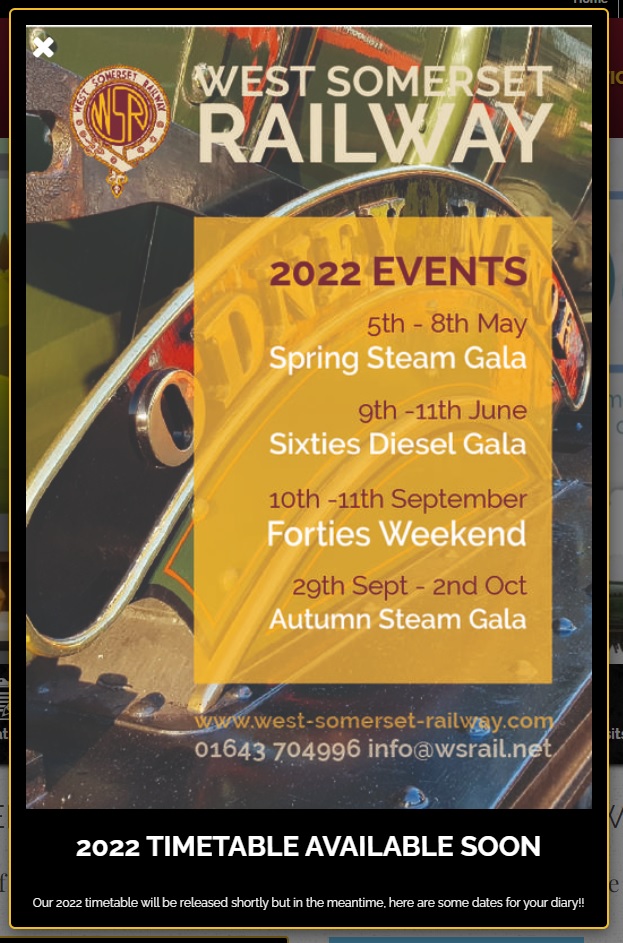Weekly Roundup – 23-Jan-22
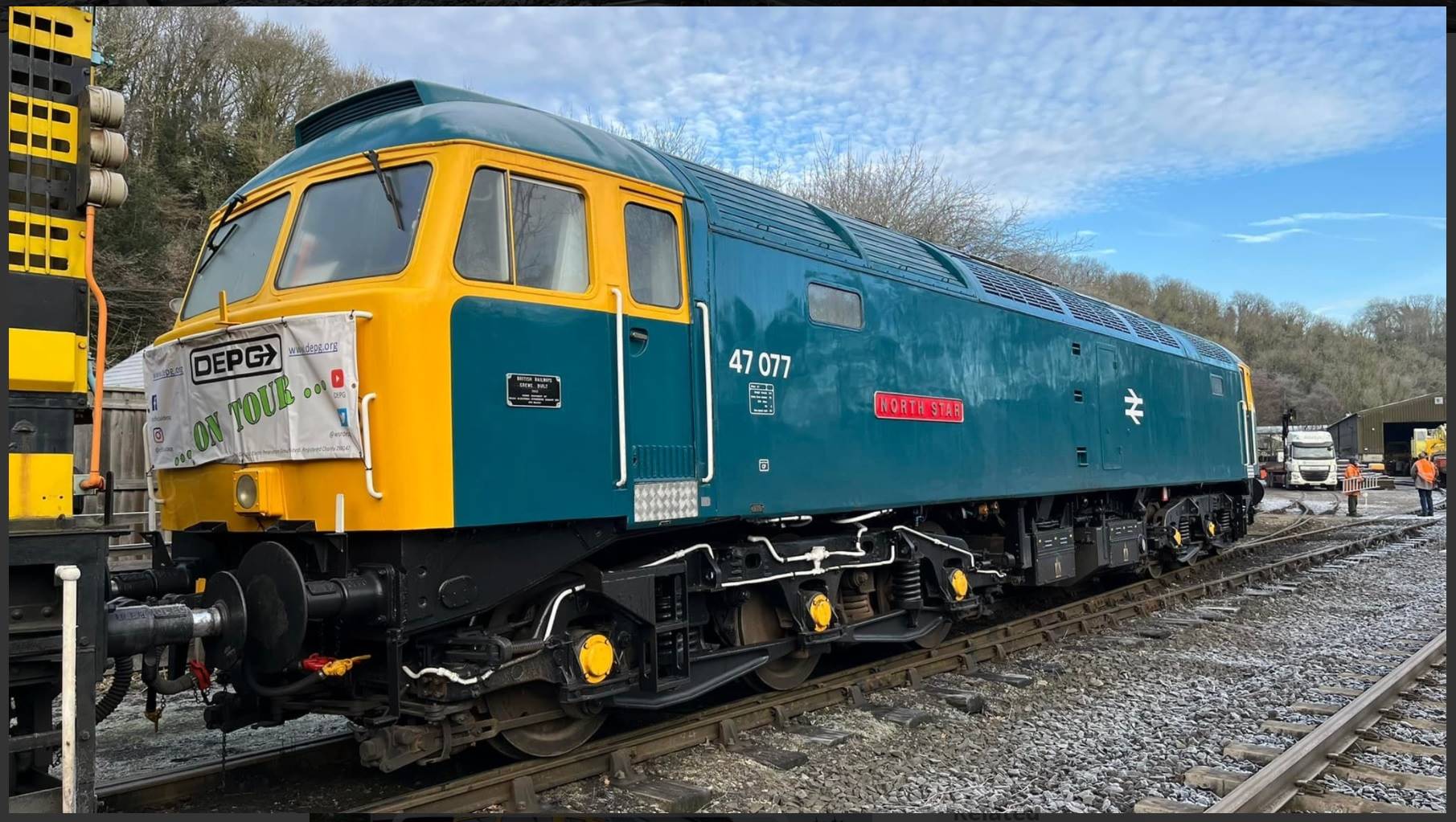
The DEPG’s BR-corporate-blue Class 47 47077 (D1661 47613 47840) ‘NORTH STAR’ was unloaded from the Allelys Heavy Haulage trailer at New Bridge on the NYMR on a freezing cold Tuesday morning 18th January 2022, after a 300-mile trip from Bishops Lydeard. The loco was the subject of an official photo shoot as part of the publicity surrounding the arrival of the loco. Photo by the NYMR © CC BY-NC 3.0
Continuing to make the news this week, our ‘celebrity’ Class 47 47077 (D1661 47613 47840) ‘NORTH STAR’ arrived at New Bridge on the NYMR at 8pm on the evening of Monday 17th January after a 300-mile journey from Bishops Lydeard that had commenced on the morning of Thursday 13th January 2022. The tortuous route involved running through Bristol during the evening rush hour, due to weight restrictions on the Avonmouth Bridge, and another diversion from the M5 through the small streets of Tewkesbury because of a weight restriction on the M5 in that area. The Allelys Heavy Haulage rig spent Thursday night parked up at Strensham Services then made the short journey to the Allelys yard near Redditch on the Friday. The rig was back on the road on Monday and the loco was unloaded on Tuesday morning, by which time the temperature was a very chilly -3C !
Several videos featuring the loco and her journey have appeared on YouTube, including the two below:
The DEPG’s YouTube video covering the loading procedure at Bishops Lydeard has now been posted on the WSRTV channel so please watch that video as well, to give support to WSRTV. Click here to view the video on WSRTV.
47077 will remain at Pickering until the line to Grosmont is re-opened after completion of the bridge renewal work that is currently taking place. The loco will then undergo completion of the overhaul that was started at Williton and will then be used between Pickering and Grosmont while crew training takes place. At some point in the future, if all goes well, the NYMR may consider updating the loco’s Train Protection & Warning System (TPWS) so that the loco will be able to work on Network Rail metals to Whitby. One step at a time; we first look forward to the loco being used on scheduled NYMR services in the summer of this year.
VERY IMPORTANT DATES FOR YOUR DIARY – the WSR’s 2022 Diesel Gala will take place from Thursday 9th through Saturday 11th June 2022, so keep these dates free and make a plan to attend ! Click this link to the WSR website to view the dates for other WSR events that are planned for 2022.
LOCO NEWS:
Class 52 D1010 ‘WESTERN CAMPAIGNER’ – work is proceeding on several fronts, and this has only become possible because our volunteer team has expanded. We are now consistently achieving 4 days of work per week and this is making a big difference to the rate of progress, but the pace will soon become limited by lack of funds to cover materials and consumables – so please keep on donating to allow us to keep the work progressing.
In the last week, we have made more progress on the bodywork repairs, more progress on stripping the paint and filler from the bodyside, more progress on the pipework and we have re-started the work on the transmission. To keep all of this moving, we need more volunteers and we need more funds, so we are going to be gearing up our efforts to get more of both and get D1010 back up to scratch. We have plenty to do, but we are gaining momentum !
If you can help by donating your time, then please JOIN US and come along to the depot for an introduction to what we do and how we do it. We currently have people on site from Saturday through to Tuesday and we can open on other days if we can be sure of getting at least two volunteers on site at all times, so there is plenty of scope. We have tasks of all types to suit most capabilities, both skilled and unskilled. Here’s some photos of the work that has taken place during the last week:
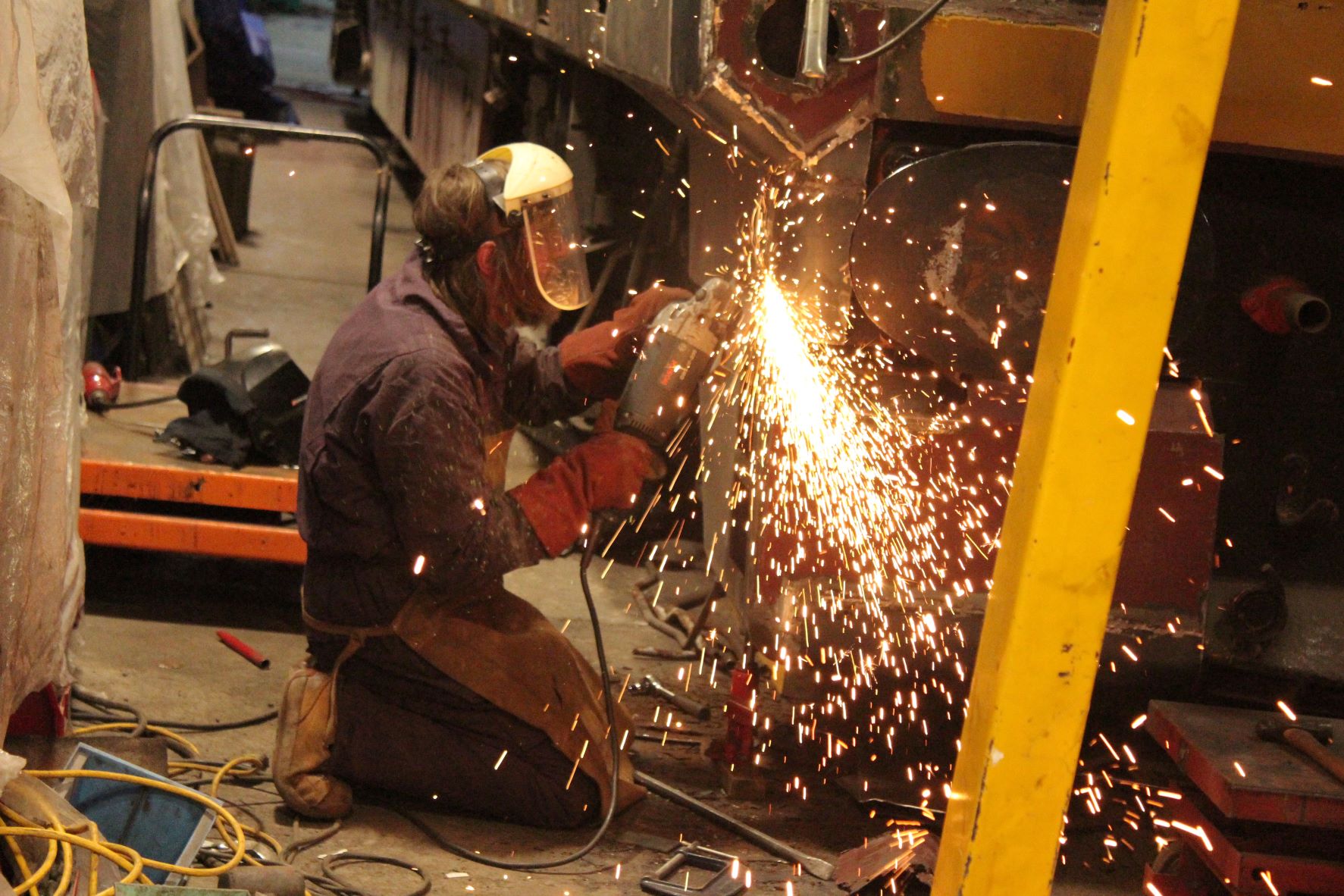
D1010 – the rebuild of the front corner on the secondman’s side of ‘B’ end cab has been completed by Colin and is now ready for rubbing down and painting. Pictured at Williton on Sunday 23rd January 2022 by Leroy Ford © CC BY-NC 3.0

D1010 – Colin’s attention then shifted to inside the cab and the repair of the second row of structural columns that each contribute to supporting the weight of the cab. While working in very cramped and crowded conditions that are not apparent from this view, the columns have now been repaired (the load is transferred to the girder that is beneath the rusty deck plate) and this will allow the wiring conduits and cab floor to be reinstated. Photo taken at Williton on Sunday 23rd January 2022 by Colin Foxhall © CC BY-NC 3.0
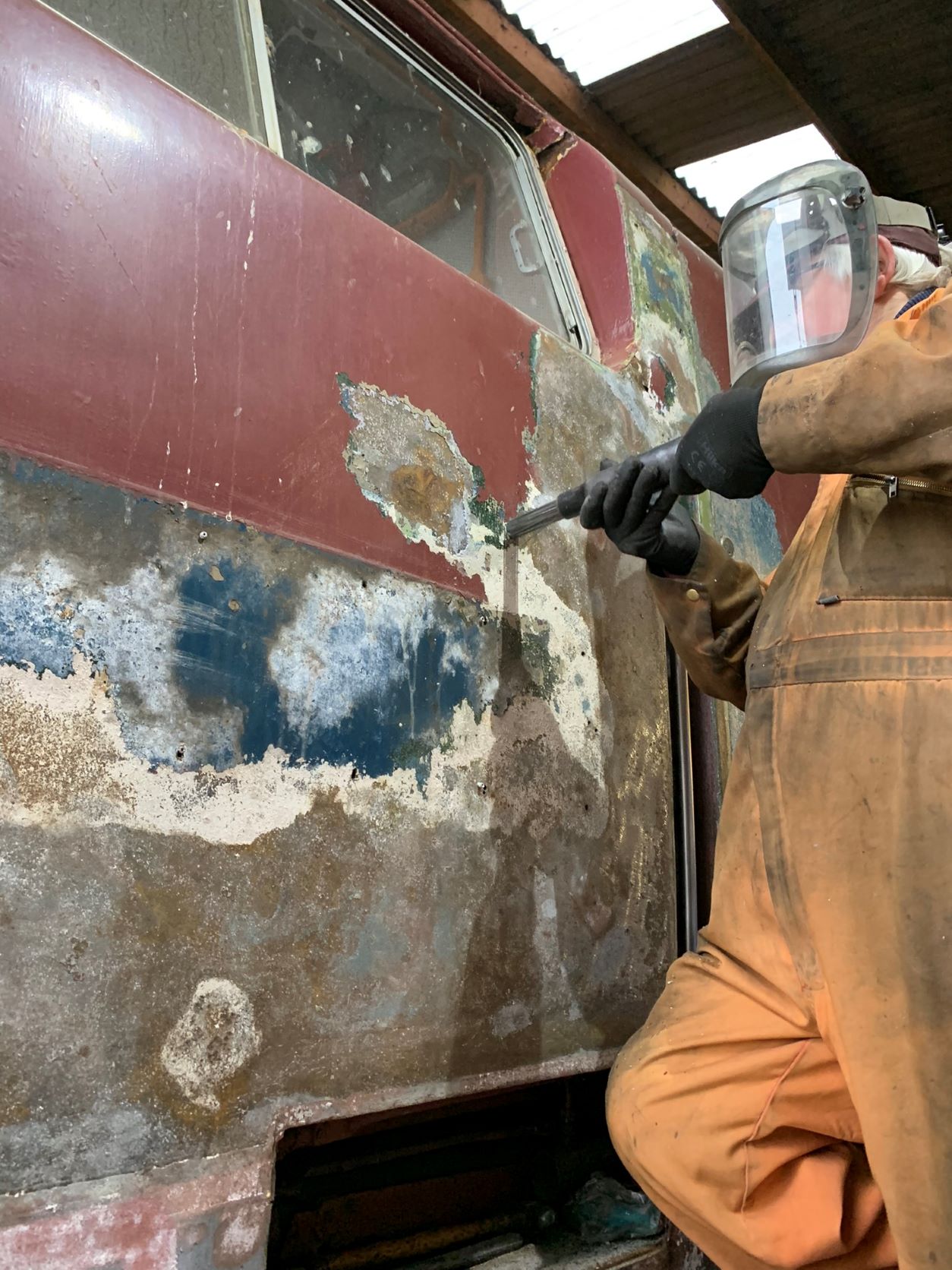
D1010 – meanwhile, Gordon continued the progress with the needle-gunning of the entire loco, seen here working on the driver’s side of ‘A’ end at Williton on Saturday 22nd January 2022. Photo by Andy Royal © CC BY-NC 3.0
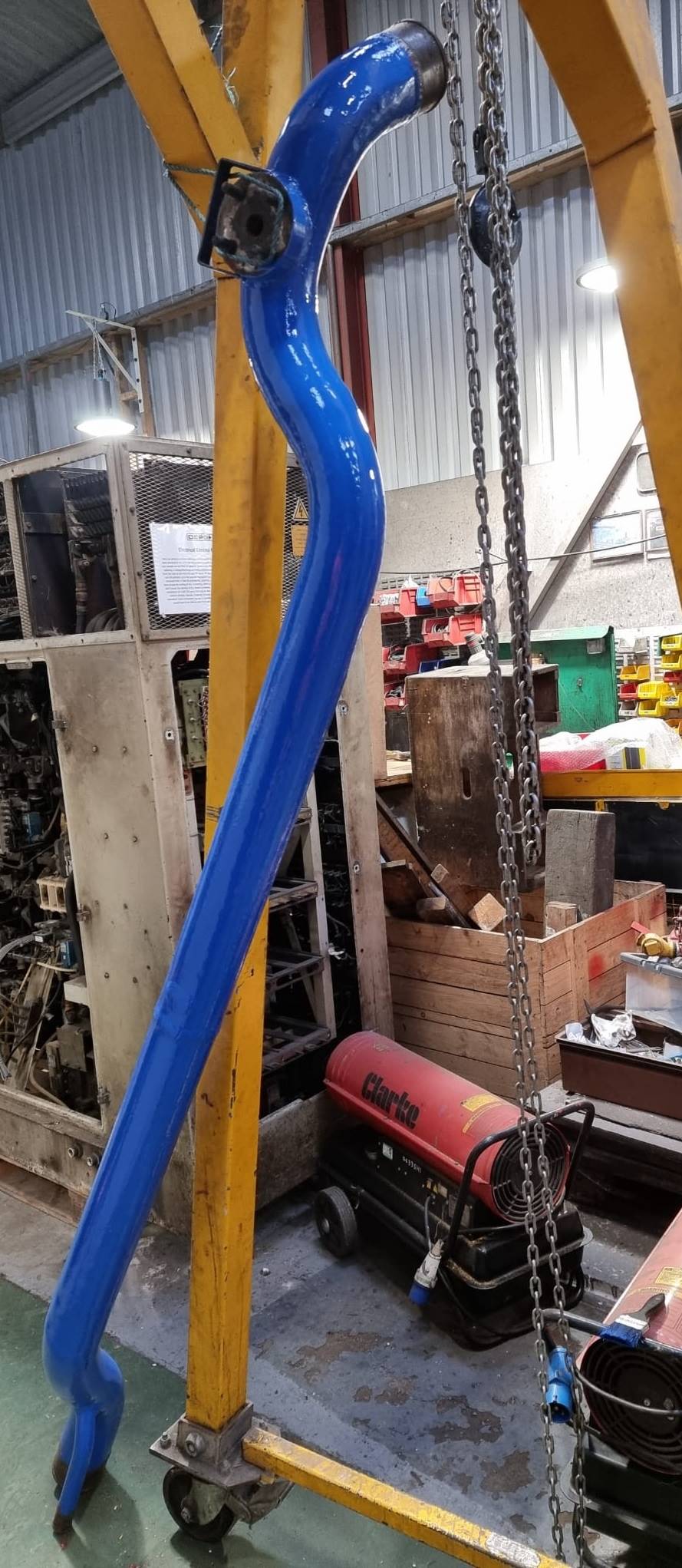
D1010 – the pipes that carry the cooling water for the engine and transmission are coloured blue by convention, for easy identification. One of the larger pipes has been cleaned, inspected, repaired and repainted and has been hung up to dry before reinstalling it on the loco. Pictured at Williton on Sunday 23rd January 2022 by Leroy Ford © CC BY-NC 3.0
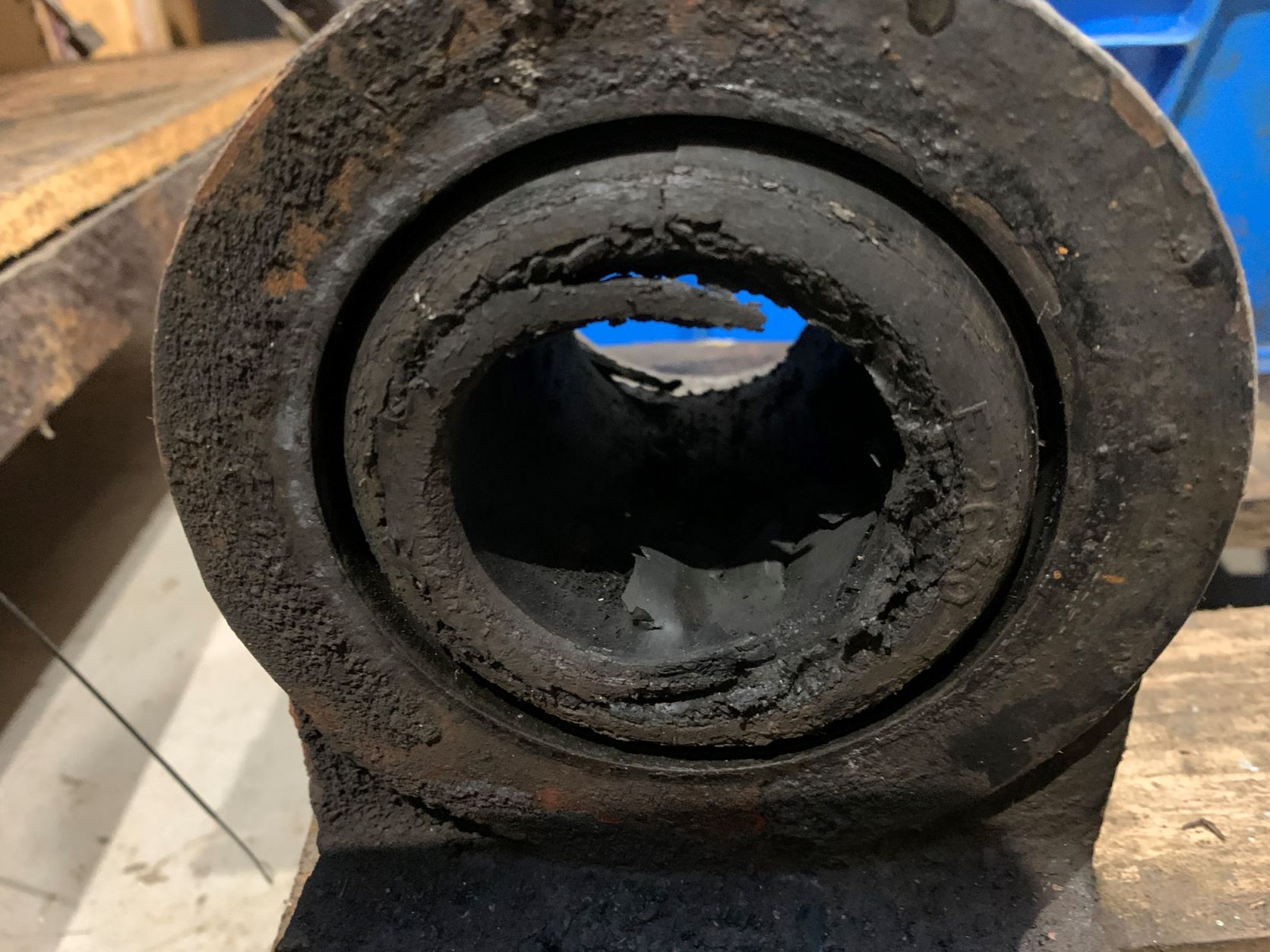
D1010 – each transmission unit is mounted on four giant rubber-to-metal bushes, and each of these has to be cleaned and inspected. This one is not fit for further service and has to be replaced or reconditioned. Pictured at Williton on Saturday 22nd January 2022 by Andy Royal © CC BY-NC 3.0

D1010 – this is one of the steel pins that goes through the transmission mounting. The size of the nut gives the scale of the part. The pin passes through a steel sleeve that is supposed to be bonded to the rubber and remain within the mounting. Not so in this case ! Pictured at Williton on Saturday 22nd January 2022 by Andy Royal © CC BY-NC 3.0
We are making good progress but there is plenty more to do, including the repair of the many small parts such as hinges and stays, conduits and pipework, all of which has suffered from the effects of the weather over the last 50 years since D1010 last underwent a major works overhaul at Swindon (in 1972) – see our D1010 timeline page for details.
On completion of the bodywork repairs, the loco will be repainted into the colour scheme that she wore when she first entered service in October 1962, overall maroon with a yellow buffer beam. The loco ran in this livery until March 1963 when the more familiar small yellow warning panel was added and the bufferbeam was changed from yellow to black. D1010 wore this livery again back in 2001, for one season. For more information on liveries, see our booklet ‘D1010 – FROM MEREHEAD TO MINEHEAD‘.
This loco is the subject of a fundraising appeal so please follow this link to find out more. We need your help ! In addition to funds, we also need plenty of HANDS. If you love the ‘Westerns’ and you are not already a member of the DEPG, please join us so that you can become one of the team that is returning D1010 to full operational condition.
-
 Donate £1 to D1010£1.00
Donate £1 to D1010£1.00 -
 Donate £10 to D1010£10.00
Donate £10 to D1010£10.00 -
 Donate £25 to D1010£25.00
Donate £25 to D1010£25.00 -
 Donate £100 to D1010£100.00
Donate £100 to D1010£100.00
Class 33 D6566 (33 048) – this loco is at Williton undergoing some minor repairs and maintenance, while remaining fully serviceable.
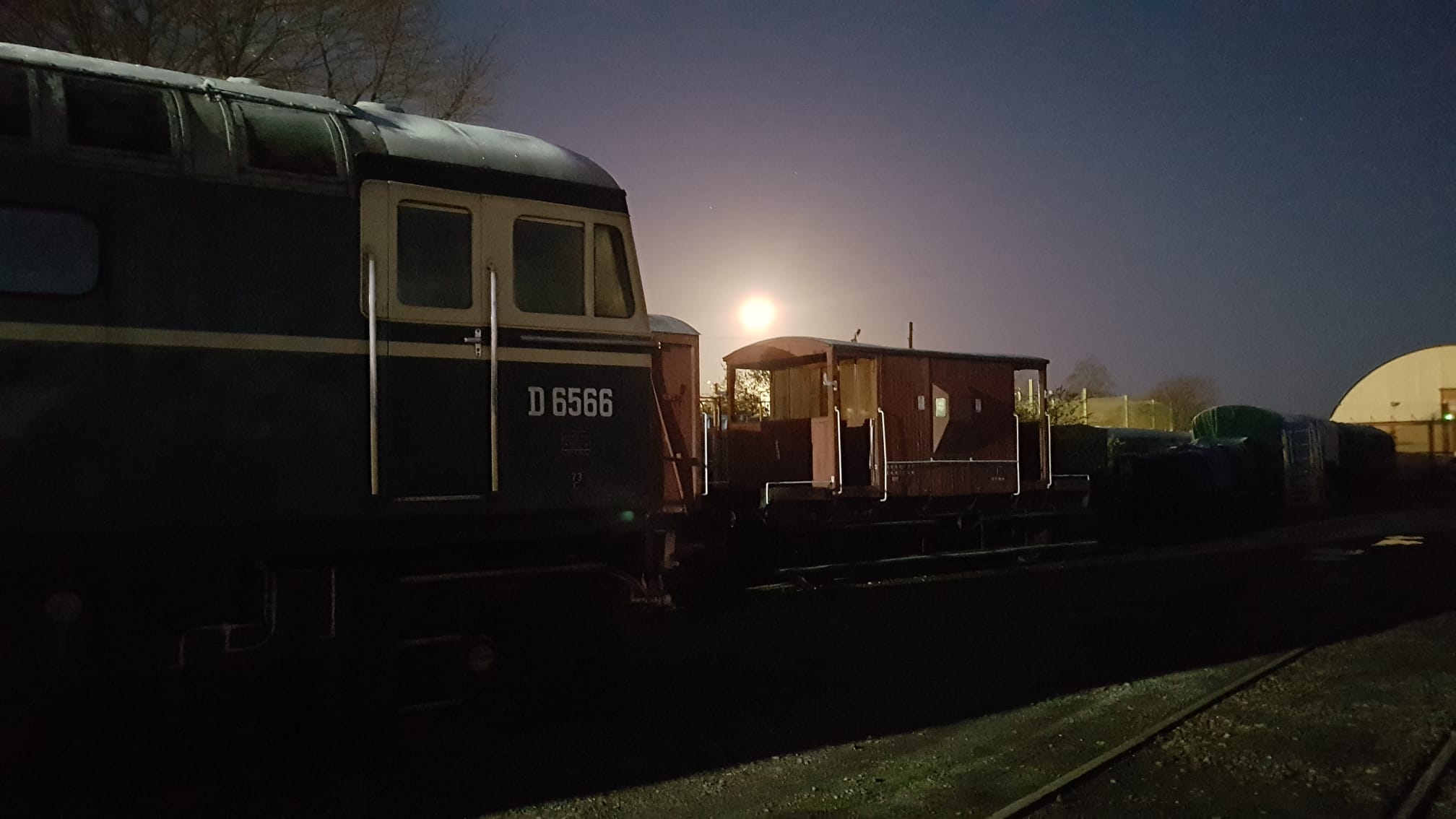
Class 33 ‘Crompton’ D6566 (33 048) pictured defore dawn on the clear and frosty morning of Monday 17th January 2022 with the ‘wolf moon’ descending over the DEPG’s 1954-vintage brake van number B952527. Photo by Martin Howard © CC BY-NC 3.0
Class 33 D6575 (33 057) – currently the duty loco, stationed at Bishops Lydeard (under cover, in Westridge Shed).
Class 35 ‘Hymek’ D7017 – the work on fitting additional fuse protection into the electrical feed for the compressor is awaiting parts delivery, so no work was performed on this loco during the last week. We expect to receive the parts in time for the coming weekend.
Class 35 ‘Hymek’ D7018 – other priorities prevented our Chairman Martin Howard from resuming his work on disassembling the transmission control block, so this loco will also be waiting until the coming weekend before she gets his attention. Both of our ‘Hymeks’ are currently stabled outdoors on number 1 road, and this exposes them to the vagaries of the weather. The ever-changing weather results in significant amounts of condensation forming within the locos and this combines with lack of use to cause maintenance difficulties. In the longer-term, this issue has to be solved by investing in covered accomodation for all of our locos, so that the restoration work is not wasted. This applies equally to heritage coaches and wagons, many of which do not get a chance of use from one year to another.
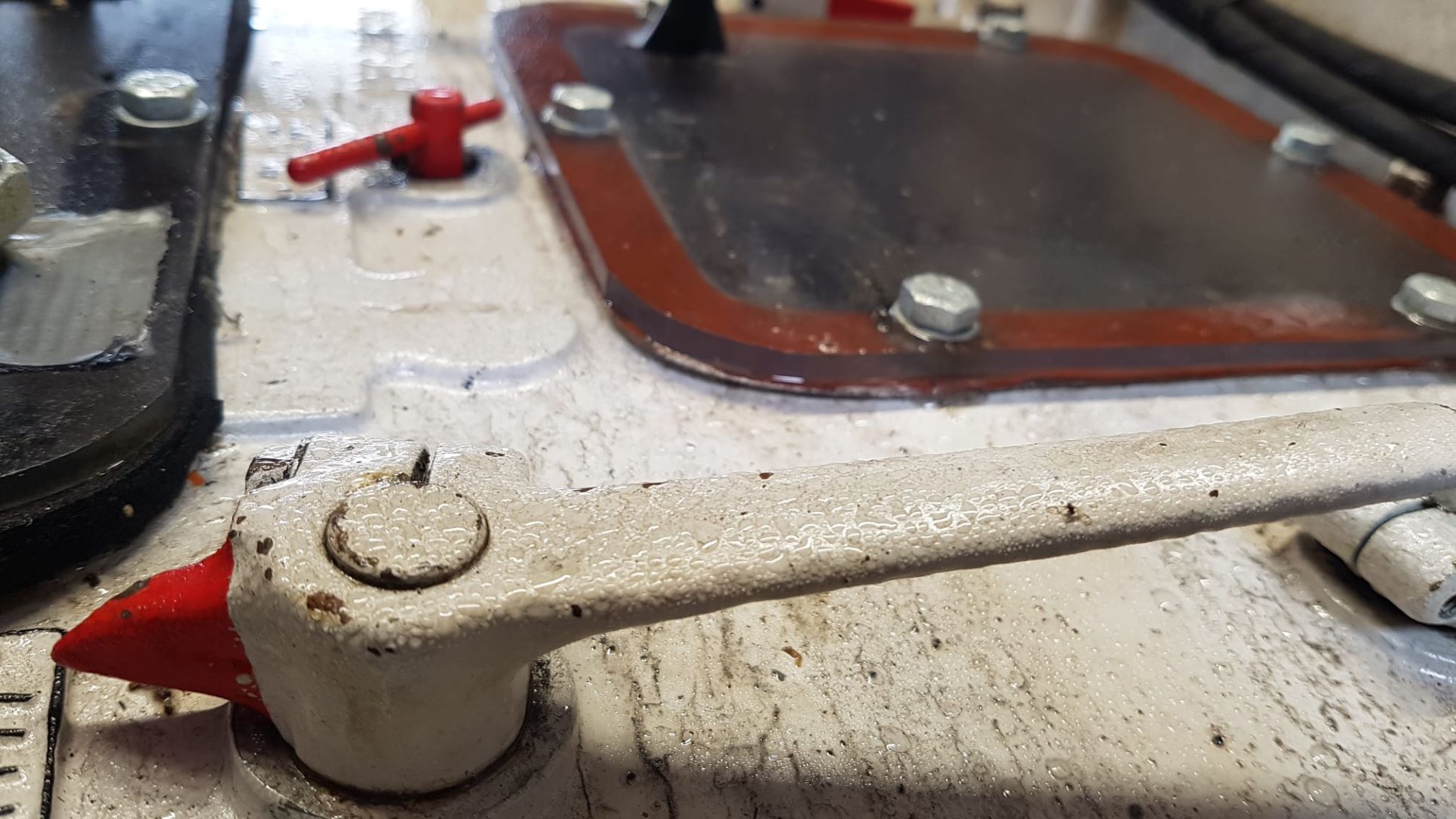
The transmission housing of ‘Hymek’ D7018 was pictured while soaked with condensation at Williton on Sunday 16th January 2022. Photo by Martin Howard © CC BY-NC 3.0
Class 14 ‘Teddy Bear’ D9518 – more progress is being made on this loco as the team spreads out to work on different parts of the frame. The photos below show pipework and valves being fitted to the frames while preparations are being made for repainting the bufferbeams. A multitude of other tasks are taking place out of sight, including the reuild of the electrical cubicle.
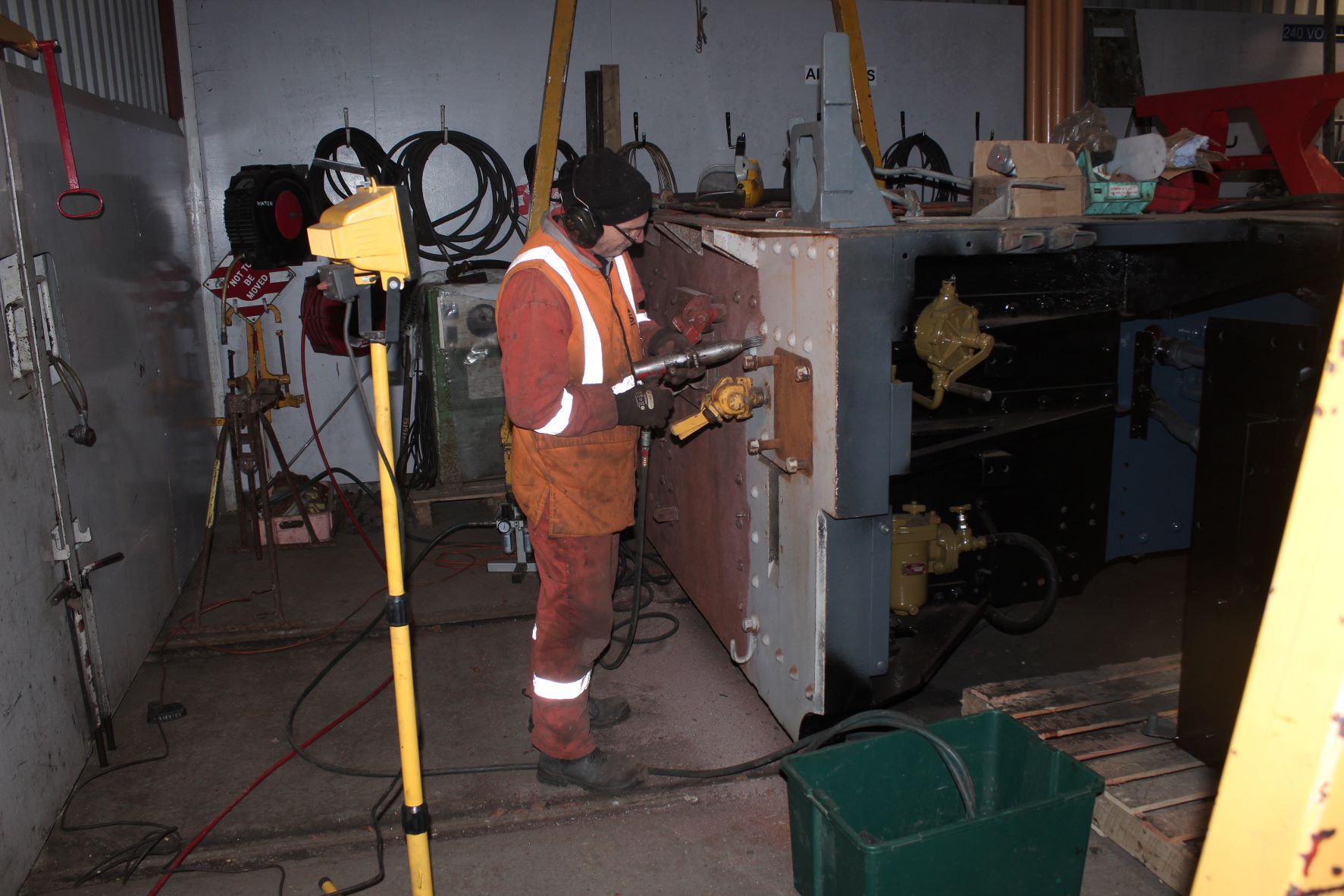
D9518’s bufferbeam at the radiator end of the loco is a steel plate that is 5 inches (127mm) thick ! This massive piece of steel is undergoing needle-gunning in the hands of Colin G to remove the loose paint and rust so that the surface can be sanded and painted. Pictured at Williton on Saturday 22nd January 2022 by Terry Deacon © CC BY-NC 3.0
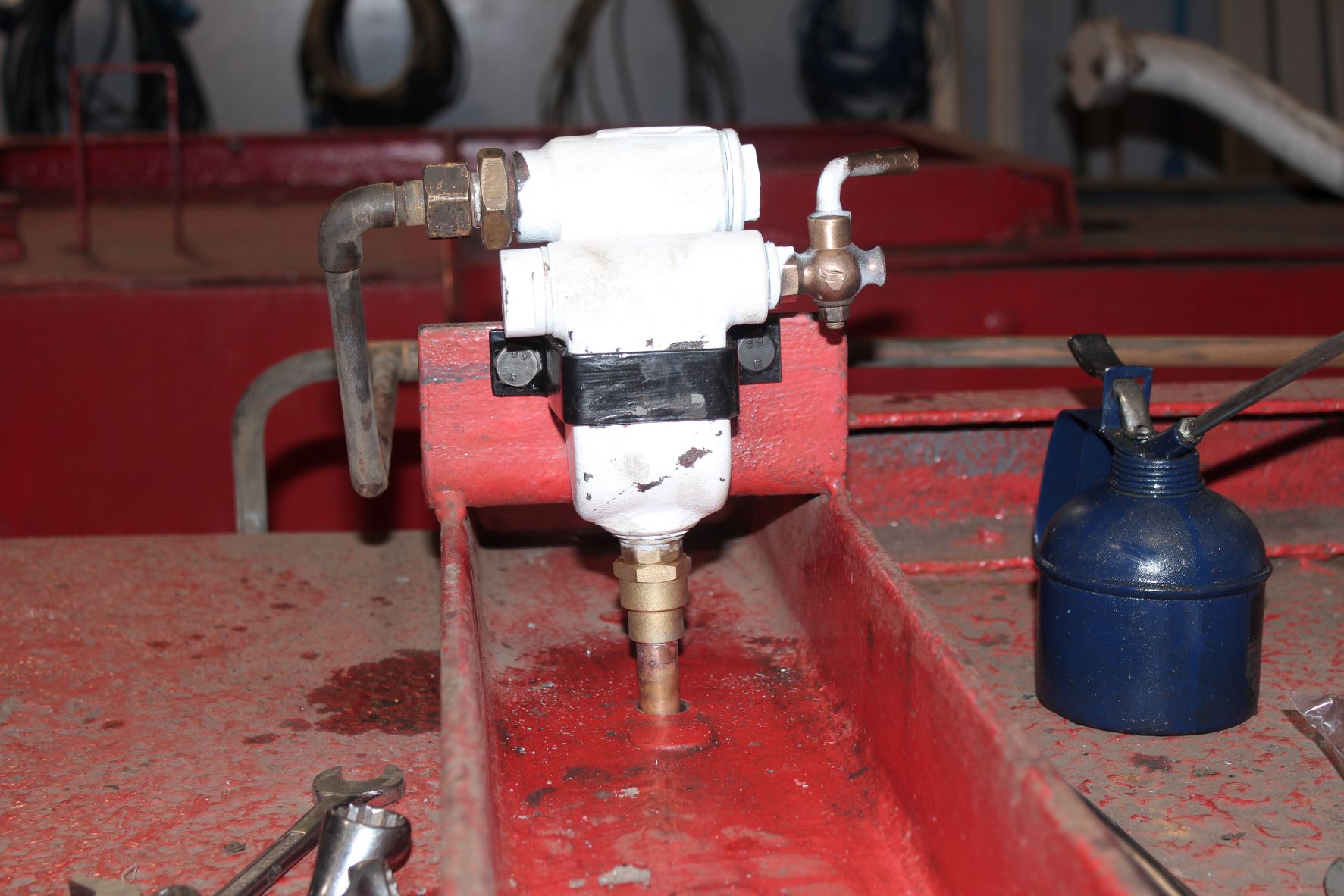
D9518’s compressed air system pipework is being reinstated along with the valves and other devices that keep the system in good working order. One such device is this BR-pattern filter and dirt trap that has been added to the system to capture any dirt particles that may be present. Pictured at Williton on Saturday 22nd January 2022 by Terry Deacon © CC BY-NC 3.0
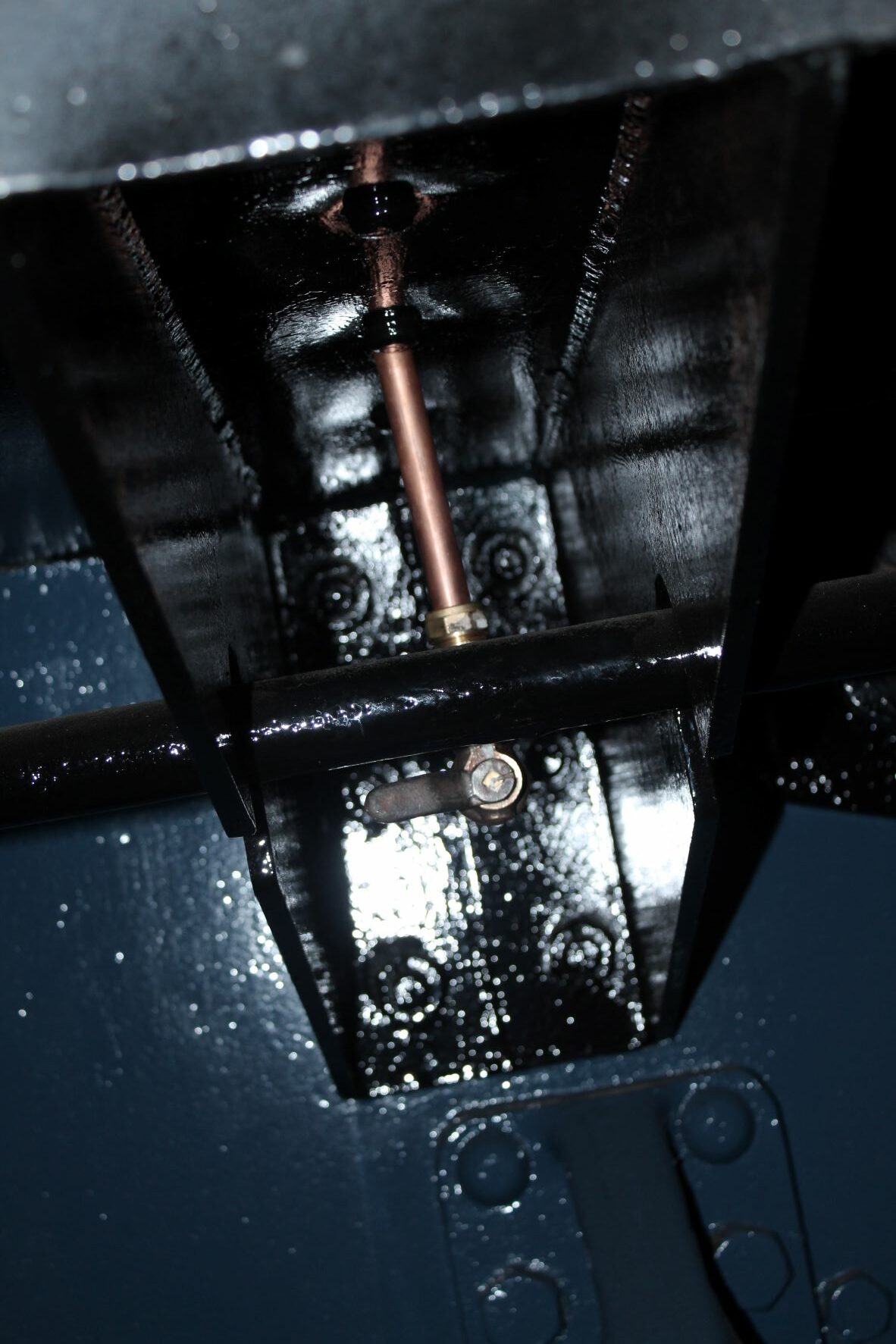
D9518 – the newly-installed filter has a vent pipe that passes down through the deck plate and can be seen in this view looking upwards, with the new copper pipe visible and the brass tap in the closed position. Pictured at Williton on Saturday 22nd January 2022 by Terry Deacon © CC BY-NC 3.0

D9518’s pipework is being reinstated piece-by-piece and this ‘information station’ provides our volunteers with guidance in the form of drawings and photographs to assist with identifying the right kind of pipework to use and where to connect it. Such information is essential for such a complex task. Pictured at Williton on Saturday 22nd January 2022 by Andy Royal © CC BY-NC 3.0
The constant progress on this loco project has been made possible by the efforts of volunteers and the donations of the many ‘Teddy Bear’ supporters who have contributed to the D9518 Restoration Appeal. Thank you all very much !
This loco is the subject of a fundraising appeal so please follow this link to find out more. We need your help ! In addition to funds, we also need plenty of HANDS. If you love the ‘Teddy Bears’ and you are not already a member of the DEPG, please join us so that you can become one of the team that is going to return D9518 to full operational condition as ‘NCB No. 7‘.
-
 Donate £1 to D9518£1.00
Donate £1 to D9518£1.00 -
 Donate £10 to D9518£10.00
Donate £10 to D9518£10.00 -
 Donate £25 to D9518£25.00
Donate £25 to D9518£25.00 -
 Donate £100 to D9518£100.00
Donate £100 to D9518£100.00
Class 14 ‘Teddy Bear’ D9526 – this loco is currently based at the Kent & East Sussex Railway and will remain at the K&ESR until May 2022, by which time her older sister D9504 should have completed her heavy overhaul and be returned to traffic. We look forward to seeing D9526 back at Williton in time for the WSR’s 2022 Diesel Gala that takes place from Thursday 9th through Saturday 11th June 2022.

Class 14 ‘Teddy Bear’ D9526 was at work on the K&ESR on Tuesday 18th January 2022 and is pictured while returning to the carriage shed at Rolvenden in the misty darkness. Photo by Chris McNaughton © CC BY-NC 3.0
Andrew Barclay 0-4-0DH 578 – this loco is currently in the Swindon Shed at Williton receiving attention from the WSR Restorations team who are performing a partial repaint that will then allow the loco to be stabled in the yard for the rest of the winter. The paint job will be completed at a later date, when the weather permits, but this approach will ensure that the bodywork is protected in the meantime.
Other vehicles at Williton – the DEPG owns several other items of rolling stock including this 1954-vintage 20-ton brake van number B952527. This vehicle is used for the Diesel Driver Experience Courses that are operated by the WSR so we need to get it into decent condition so that it can go back into service later in the year. Step 1 is to clean up the vehicle and remove the detritus that has gathered after more than two years without use and Step 2 is to assess the extent of repairs required, then Step 3 is to arrange for the repairs to be carried out. We have made a start on Step 1 !
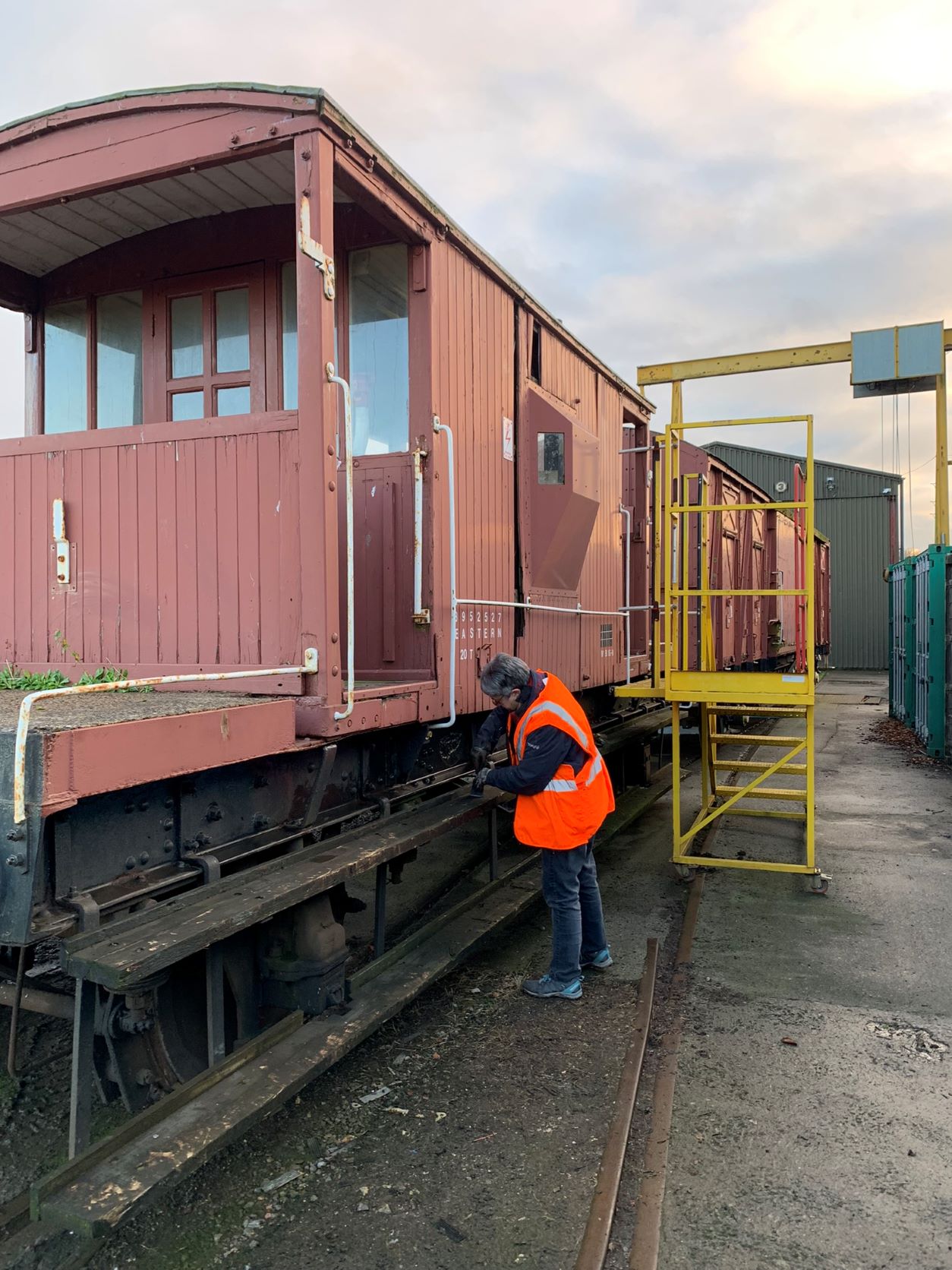
BR-1954 (Faverdale) 20-ton brake van (aka guard’s van) number B952527 gets some TLC from Carol at Williton on Sunday 16th January 2022. Photo by Andy Royal © CC BY-NC 3.0
Another important aspect of volunteering is the learning of new skills, so Colin F gave some of his time to help fellow volunteers Paul C and Mike E expand their metalworking skills to include the techniques for cutting and welding. It is never too late to learn a new skill, so hats off to all of our volunteers for their willingness and flexibility. We all learn from one-another !
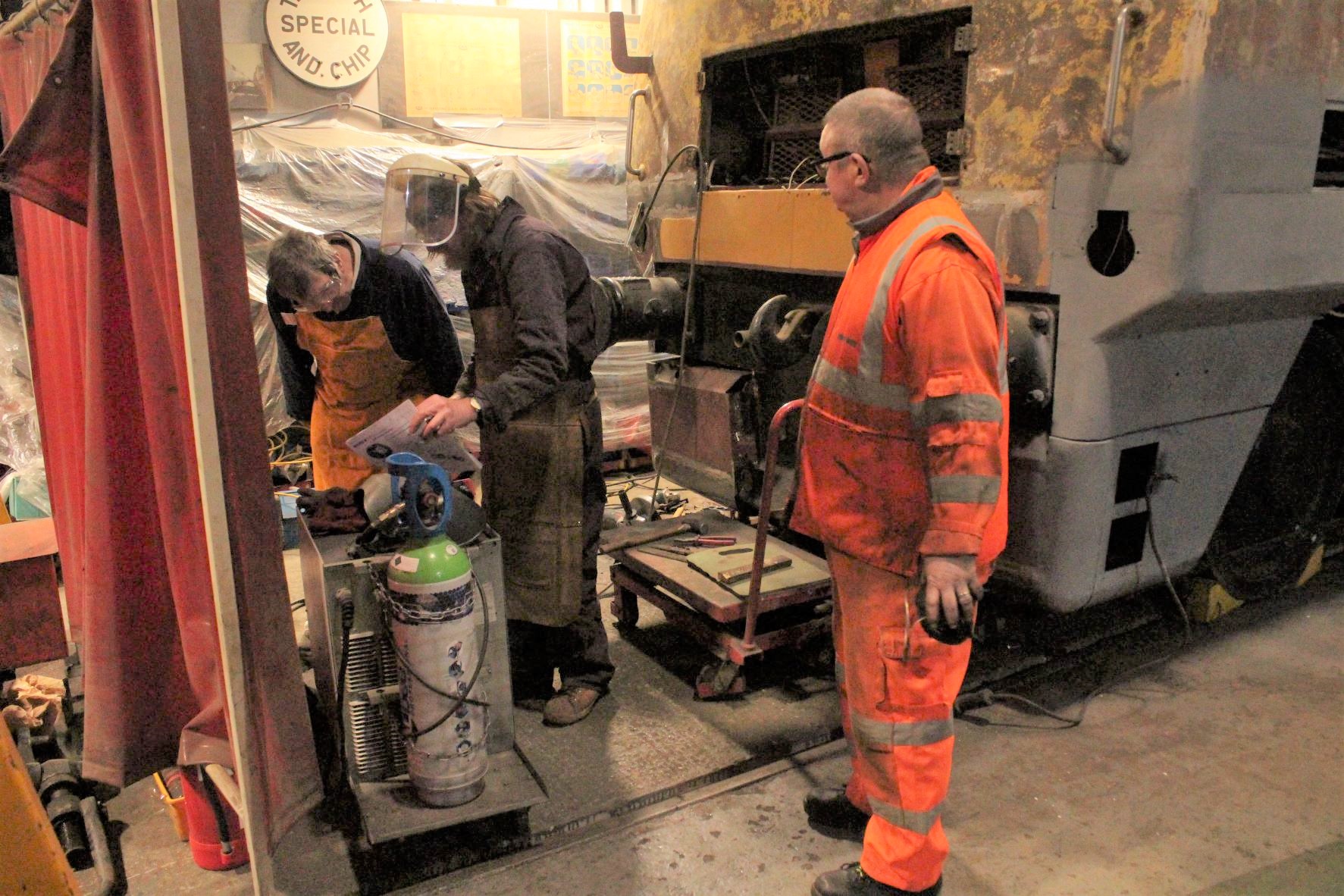
Three volunteers gathered at Williton on 22nd January 2022 to develop their skills in cutting and welding. This particular group of three have each learned additional skills and practice them at Williton as often as they can, for the benefit of our loco fleet. Photo by Terry Deacon © CC BY-NC 3.0
Many thanks to all of our volunteers who give up so much of their time to work on the cleaning, painting, maintaining, restoring, managing and fund raising for our fleet of heritage locomotives !
BOOK REVIEW – this week, we have another book review from our regular correspondent Neale Long, this time covering the new work by Andrew Fowler entitled ‘THE DELTICS & BABY DELTICS – A TALE OF SUCCESS AND FAILURE‘ and published by Pen & Sword Books in May of 2021.
Here below is Neale’s report:
“As part of the Pen and Sword Locomotive Profile Series, author Andrew Fowler spotlights two English Electric locomotive classes with contrasting fortunes, namely the world-beating Class 55 ‘Deltics’ and their much less success brethren, the Class 23 ‘Baby Deltics’. He does this through this 197 page tome which is set out in a number of chapters, namely:
- Prelude to the ‘Deltics’
- The Prototype ‘Deltic’
- The ‘Baby Deltics’
- The Production Series ‘Deltics’ – an introduction
- Chapters on each production series ‘Deltic’ from D9000 to D9021 (55001 – 55022)
Well written and produced in the usual Pen and Sword style, the book starts with a brief introduction of the commencement of modern traction on the newly nationalised British Railways covering the pioneering LMS locomotives, Bulleid’s 10201-3 and the modernisation plan of 1955, this introduction being suitably illustrated with some historical images.
The book then tells the story of the prototype ‘Deltic’, before then focusing on the ‘Baby Deltics’ and their particular difficulties. It then proceeds to tell the story of the 22 production-series locomotives which achieved great success on the Eastern Region of BR, replacing over 60 steam locomotives and which revolutionised the schedules on the East Coast route. The last part of the book then devotes a section to each individual production series locomotive commencing with D9000 and ending with D9021, each section containing a brief outline of the individual locomotives’ history.
The chapters set out the story of both classes adequately and the introduction sets out the classes in context of a railway system that was modernising in the face of a deepening financial crisis. It is a generalised account of these locomotive classes which had contrasting fortunes, rather than a detailed account. Nicely illustrated in both colour and monochrome, many of the photographs feature Class 55s in blue livery rather than the earlier two-tone green, which may disappoint some Class 55 enthusiasts.
To those expecting a book on the lines of Anthony Sayer’s excellent locomotive portfolios on classes 21/29, 28, 15/16 & 17, this volume differs as is not in that series, being a locomotive ‘profile’ series book rather than the more detailed locomotive ‘portfolio’ series, this book providing a more generalised account of ‘Deltics’ and ‘Baby Deltics’. Within that context, this book provides a reasonable account and the author has compiled a volume that will surely appeal to the many ‘Deltic’ enthusiasts and can be recommended particularly to those seeking an introduction to the story of these locomotives.”
Many thanks to Neale for providing us with this review.
ON SHED – we feature another photo from the extensive collection of Devon-based photographer Barry Gay, capturing the scene at Newton Abbot during the twilight years of the depot. This week, we feature a Class that has always been closely associated with Newton Abbot, ever since the first examples were put to work on the South Devon banks in January of 1959. Sadly, none of this Class or their diesel-electric cousins (Classes 21 and 29) have survived in preservation, but there is an effort being made by the PROJECT 22 SOCIETY to create a new-build locomotive, and we hope that this project may one day deliver a representative example of a mainline North British diesel locomotive. We wish them every success with their enormous task.
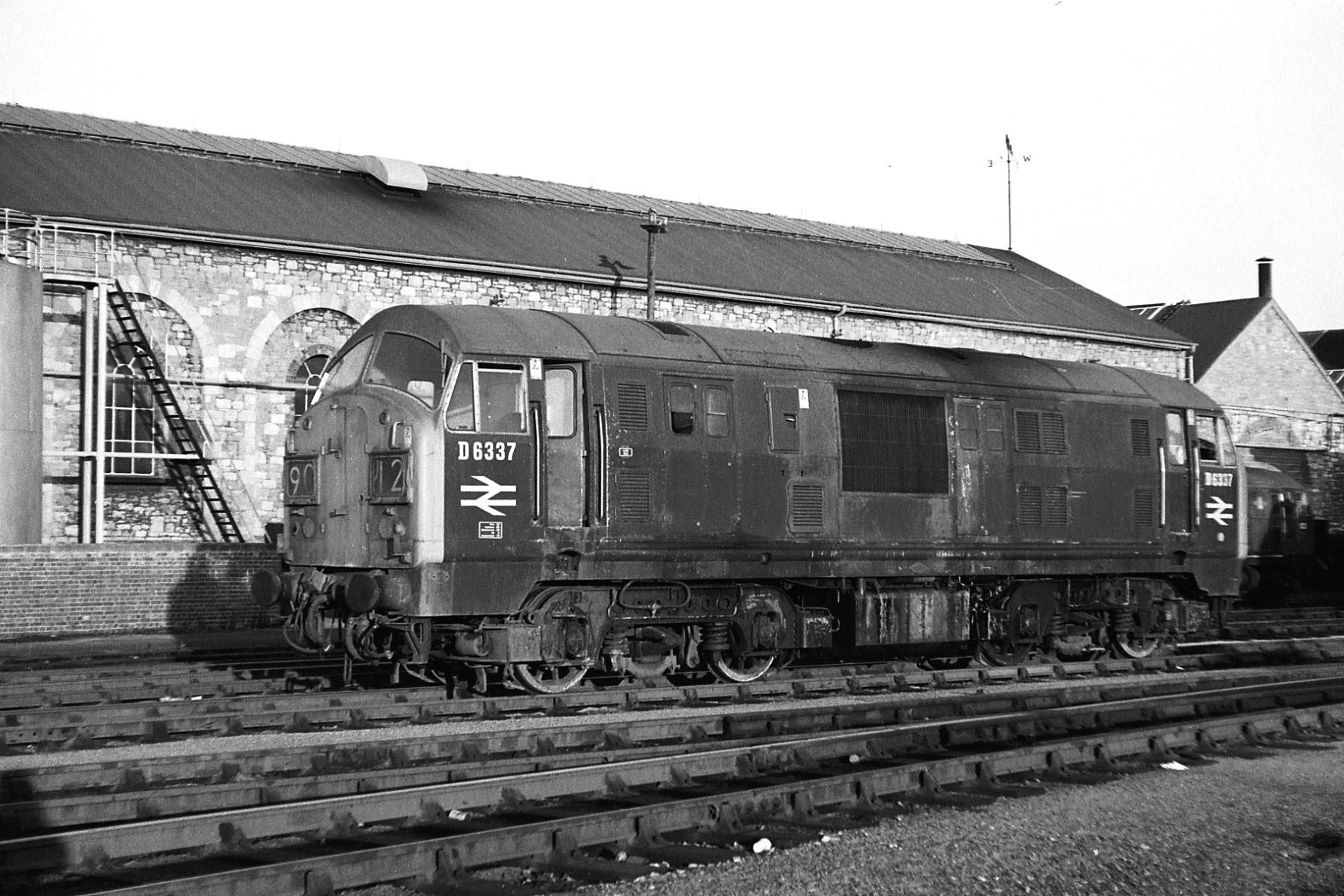
North British Locomotive Company Type 2 diesel-hydraulic Class 22 number D6337 stands at Newton Abbot loco shed after being refuelled on the evening of 5th July 1971. This loco entered service at Newton Abbot on 13th March 1962 and was withdrawn on 21st October 1971 after a short operational life of less than 10 years. The loco was broken up at Swindon Works in May of 1972. Photo by Barry Gay © CC BY-NC 3.0
Many thanks to Barry for sharing his photos with us all !
DEPG NEWS – we will be contacting our membership this week to remind members to renew their subscriptions so that we can keep our membership base growing. This is essential so that we can provide long-term security for the DEPG locomotive fleet. Please reply to this email or use our CONTACT FORM to let us have your opinion of how we are doing. Thanks !
A DEPG Board Meeting took place at Williton on Saturday 22nd January 2022 and a synopsis will be produced ASAP and circulated to members for whom we hold an active email address. Copies of the synopsis will be included with the next DEPG Newsletter for the benefit of those who prefer written communications. Let us know your preference – we are in the process of developing our systems to allow a more selective distribution, to reduce costs and to eliminate waste.
DEPG WEBSITE – we have some stock remaining of our seasonably warm wearables, so click the the links below to find out more !
We can also provide these garments to order in different colours, so if you want a hat or a fleece but don’t want it in black, please reply to this email or use our CONTACT FORM to let us know. Thanks !
-
 Hat – DEPG Beanie£12.50 incl VAT excl P&P
Hat – DEPG Beanie£12.50 incl VAT excl P&P
WSR NEWS: The success of the ‘WINTERLIGHTS’ services has been well covered in previous roundups, but last Monday, 17th January 2022, a special working took place where the Winterlights contractor’s team joined a team comprising WSR and DEPG volunteers to travel between Bishops Lydeard and Crowcombe Heathfield to recover the displays and artefacts that had been positioned along the line as part of the show. The special working was propelled by Class 09 shunter D4107 (09 019) under the control of DEPG Chairman Martin Howard, and the working was captured by dashcam by one of our volunteers while on his way to Williton, just as the consist passed over Coombe Florey bridge !

Dashcam capture of Class 09 D4107 (09 019) propelling the ex-GWR ‘Toad’ brake van over Coombe Florey bridge on Monday 17th January 2022 in the direction of Crowcombe Heathfield. Video capture by Geoff Miles © CC BY-NC 3.0
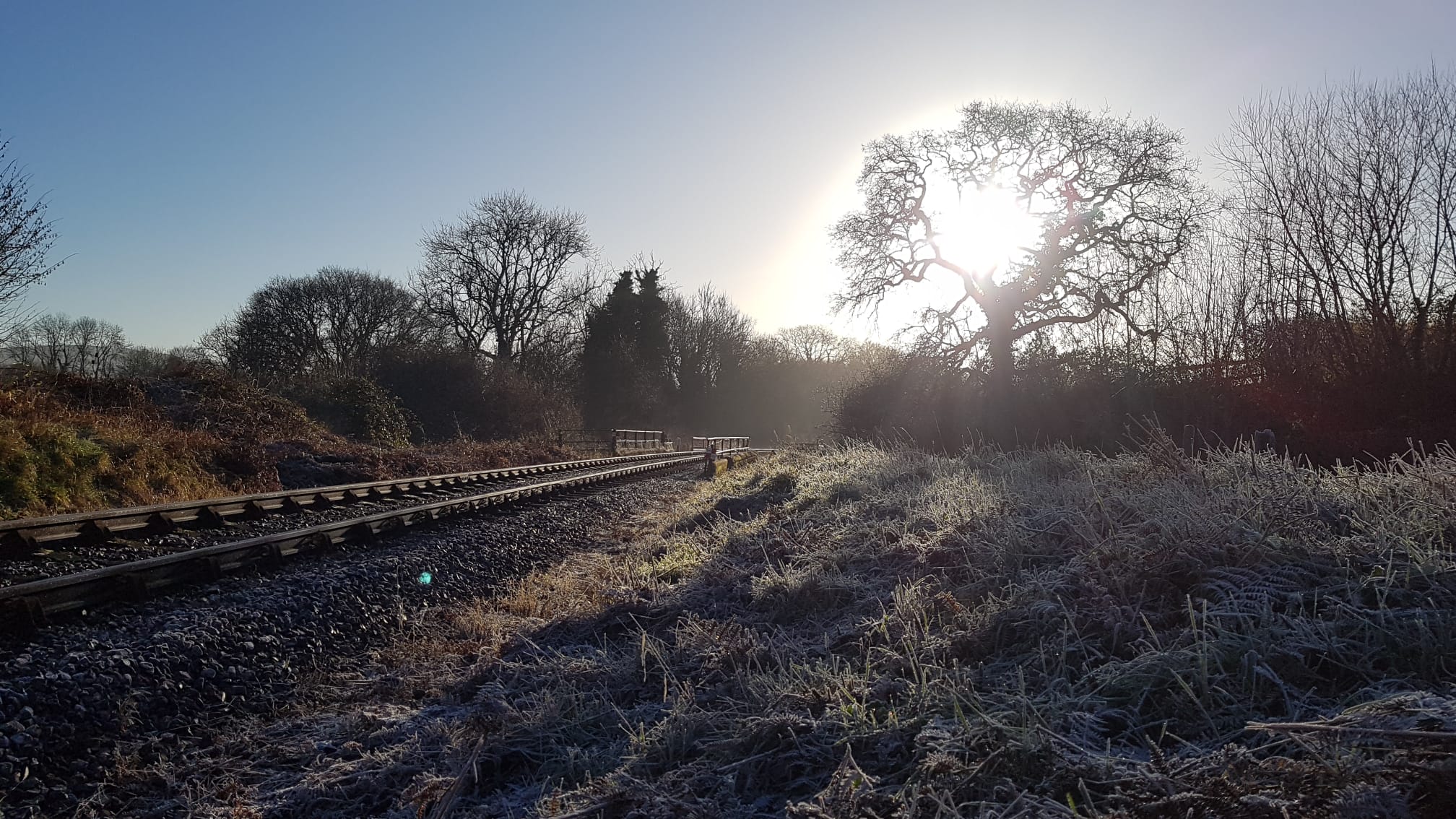
The beauty of the early morning at Nornvis on a cold and frosty Monday 17th January 2022. Photo by Martin Howard © CC BY-NC 3.0

Class 09 D4107 (09 019) stands at Nornvis while the staff from the Winterlights contractor disassemble the lineside displays and stow them in the ex-GWR ‘Toad’ brake van for safe return to Bishops Lydeard. Photo taken on Monday 17th January 2022 by Martin Howard © CC BY-NC 3.0
Class 09 D4107 (09 019) stands at Nornvis with the ex-GWR ‘Toad’ brake van on a cold but clear Monday 17th January 2022. Photo by Martin Howard © CC BY-NC 3.0
Elsewhere on the line, the track renewal project at Alcombe (between Dunster and Minehead) is proceeding well, with the trackbed prepared and the brand-new sleepers and rail in the process of being laid. The use of steel sleepers is preferred in this area because the line is built across a salt marsh, the steel sleepers being more suited to the ground conditions. For more photos of this work taking place, click this link to visit wsr.org.uk. It is great to see investment on this scale and we look forward to running over the new formation in the spring.
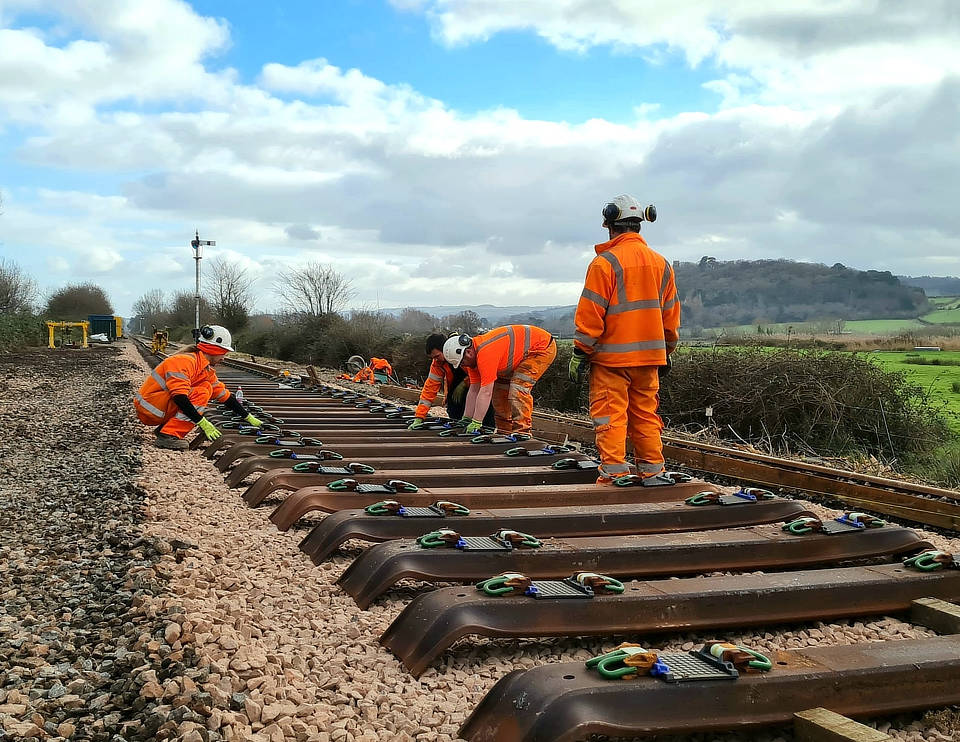
Track renewal work at Marsh Common, Alcombe, with members of the WSR Infrastructure Permanent Way gang aligning the new steel sleepers before installing the new rails. Pictured on Thursday 20th January 2022 by the WSR Infrastructure team © CC BY-NC 3.0
The WSR have published the dates for the 2022 special events, as follows, so please make a note and ADD THESE DATES TO YOUR DEPG CALENDARS:
Go to previous Weekly Roundup post


